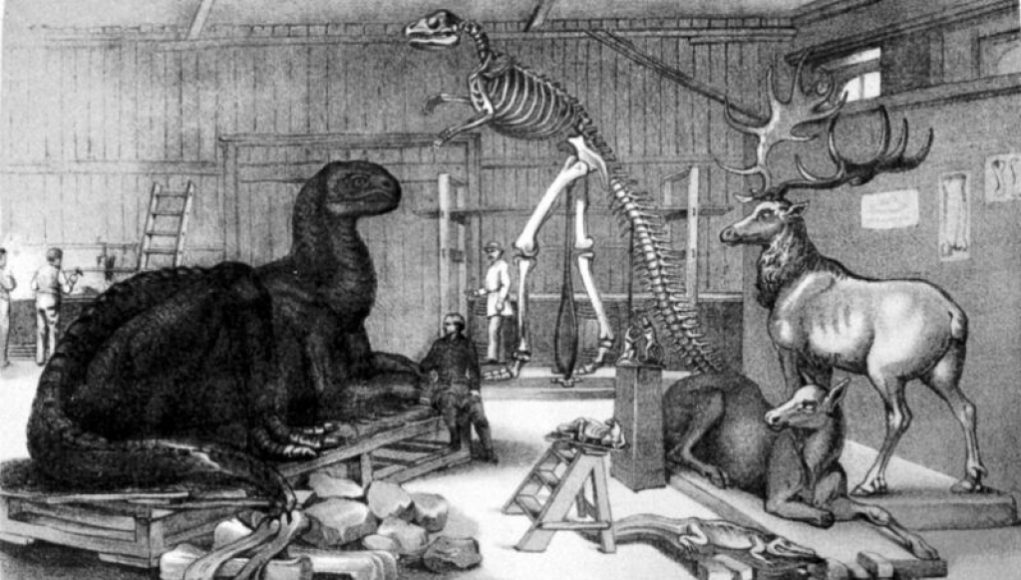Did you know that New York City’s Central Park was supposed to have a Paleozoic Museum with life-size concrete models of dinosaurs? Unfortunately, those plans were destroyed in 1871 when vandals broke into the workshop of the museum’s designer, Benjamin Waterhouse Hawkins, and smashed the models with sledgehammers. The traditional belief is that William “Boss” Tweed was behind the destruction, but a recent paper published in the Proceedings of the Geologists’ Association identifies a different culprit: a lawyer and businessman named Henry Hilton.
Hawkins was an English sculptor and natural history artist who caused a sensation at the Great Exhibition of 1851 in London with his life-size dinosaur models. Cast in concrete and designed in conjunction with paleontologist Sir Richard Owen, the models were subsequently relocated to what is now Crystal Palace Park. Hawkins was already in the US on a lecture tour, as well as designing and casting a nearly complete Hadrosaurus skeleton for the Academy of Natural Sciences in Philadelphia—the world’s first mounted dinosaur skeleton. So he was a natural choice to create life-size dinosaur sculptures for the planned Paleozoic Museum in Central Park.
The dinosaur models for the Paleozoic Museum would be based on those specimens specifically found in North America, although this was just before the famous American “bone rush” of the 1870s to 1890s yielded large numbers of fossilized dinosaur skeletons and bones. Hawkins was provided a workspace in a large brick building known as the Arsenal (or the Armory) on 64th Street, beginning with small clay models based on the available fossil evidence before making the life-size molds. Meanwhile, architects Frederick Law Olmsted and Calvert Vaux lodged their architectural plans for the museum building and dug out the foundations.
Unfortunately, the political winds were shifting in New York City by 1870. Boss Tweed disbanded the board led by Andrew Haswell Green and appointed a new board with all his own people, headed by Peter Sweeny, with Hilton serving as treasurer. By this time, plans were underway for the more ambitious American Museum of Natural History (AMNH) to be located on or adjacent to Central Park. Hawkins had to move out of the Arsenal into a nearby shed to continue his work to make room for the specimens and collections being acquired for the AMNH.
The AMNH wasn’t intended to rival the planned Paleozoic Museum; Green’s board had supported both projects. But Tweed’s newly appointed board felt differently and elected to stop the project in May 1870. The official reason was economic. Their 1871 annual report specifically cited the high cost of completing the Paleozoic Museum (some $300,000, or about $7.5 million today), all coming from public funds, unlike the AMNH, which was supported by philanthropic fundraising. This was deemed “too great a sum to expend on a building devoted wholly to paleontology—a science, which however interesting, is yet so imperfect as not to justify so great a public expense for illustrating it.” There were also plans for a zoo in Central Park, and the board favored supporting living animals over extinct ones.
In the spring of 1871, Central Park’s Paleozoic Museum was the site of a troubling vandalization, causing outrage and consternation in the local community. It took detectives over three months to uncover the perpetrator and bring him to justice, and now the full story of what happened has been revealed.
The vandalism occurred in the early morning hours of May 14, 1871. Witnesses reported hearing loud banging and smashing noises coming from the museum. By the time the police arrived, the museum’s exhibits had been destroyed, and a significant amount of artwork had been stolen from the museum’s collection.
The police investigation soon uncovered a web of suspicious activities. After a thorough review of surveillance video and witness testimonies, detectives were able to identify the main suspect, a local gang leader known as “The Black Cat”. He had been seen in the area on the night of the vandalism and was believed to be the mastermind behind the attack.
Further investigation revealed that the Black Cat had been planning his act of vandalism for weeks, enlisting the help of several of his gang members to carry out his scheme. They had targeted the museum as an easy target with valuable objects that could be quickly stolen and sold in the criminal underworld.
Over the course of three long months, detectives were able to capture the Black Cat and bring him to justice. His gang members were also arrested and charged with various crimes related to the vandalism.
Now, nearly 150 years later, the true story of this crime has been revealed. Thanks to the determined efforts of the police, the criminals responsible for the destruction of the Paleozoic Museum have been brought to justice, allowing the community to heal and move forward.




















